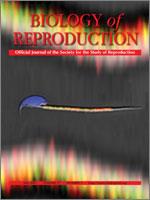Little is known regarding the role of insulin-like growth factor 2 (IGF2) and the regulation of the IGF2 receptor (IGF2R) during follicular development. Granulosa cells were collected from small (1–5 mm) and large (8–22 mm) bovine follicles and were treated with IGF2 for 1–2 days in serum-free medium, and steroid production, cell proliferation, specific 125I-IGF2 binding, and gene expression were quantified. IGF2 increased both estradiol and progesterone production by granulosa cells, and cells from large follicles were more responsive to the effects of IGF2 than those from small follicles. Abundance of aromatase (CYP19A1) mRNA was stimulated by IGF2 and IGF1. The effective dose (ED50) of IGF2 stimulating 50% of the maximal estradiol production was 63 ng/ml for small follicles and 12 ng/ml for large follicles, and these values were not affected by FSH. The ED50 of IGF2 for progesterone production was 20 ng/ml for both small and large follicles. IGF2 also increased proliferation of granulosa cells by 2- to 3-fold, as determined by increased cell numbers and 3H-thymidine incorporation into DNA. Treatment with IGF1R antibodies reduced the stimulatory effect of IGF2 and IGF1 on estradiol production and cell proliferation. Specific receptors for 125I-IGF2 existed in granulosa cells, and 2-day treatment with estradiol, FSH, or cortisol had no significant effect on specific 125I-IGF2 binding. Also, FSH treatment of small- and large-follicle granulosa cells had no effect on IGF2R mRNA levels, whereas IGF1 decreased IGF2R mRNA and specific 125I-IGF2 binding. Granulosa cell IGF2R mRNA abundance was 3-fold greater in small than in large follicles. These findings support the hypothesis that both IGF2 and its receptor may play a role in granulosa cell function during follicular development. In particular, increased free IGF1 in developing follicles may decrease synthesis of IGF2R, thereby allowing for more IGF2 to be bioavailable (free) for induction of steroidogenesis and mitogenesis via the IGF1R.
How to translate text using browser tools
1 July 2007
Insulin-Like Growth Factor (IGF) 2 Stimulates Steroidogenesis and Mitosis of Bovine Granulosa Cells Through the IGF1 Receptor: Role of Follicle-Stimulating Hormone and IGF2 Receptor
L. J. Spicer,
P. Y. Aad
ACCESS THE FULL ARTICLE

Biology of Reproduction
Vol. 77 • No. 1
July 2007
Vol. 77 • No. 1
July 2007
follicle
follicular development
granulosa cells
IGF2 receptor
insulin-like growth factor 2
insulin-like growth factor receptor




